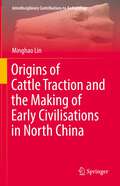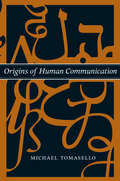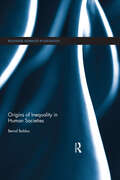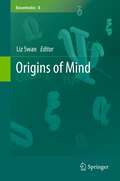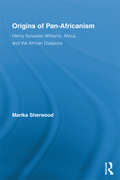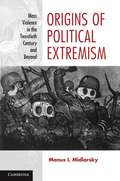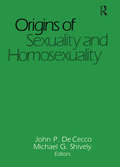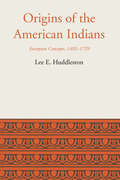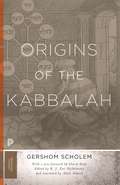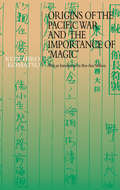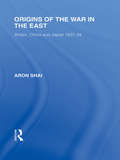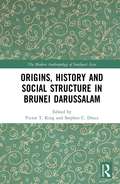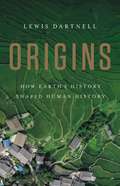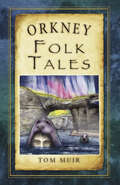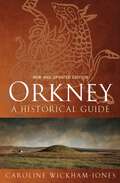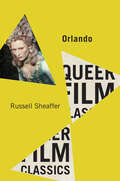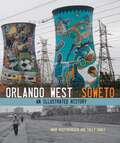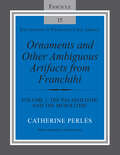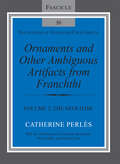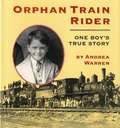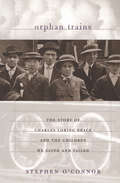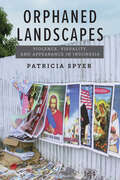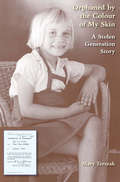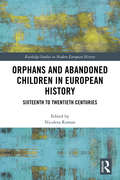- Table View
- List View
Origins of Cattle Traction and the Making of Early Civilisations in North China (Interdisciplinary Contributions to Archaeology)
by Minghao LinThis book is the first to apply systematic palaeopathological, archaeological and historical investigations (using bones as a focus as well as other supporting lines of information) to Chinese osteological materials in order to answer the question about the origins of cattle labour. Structurally, this monograph flows from an introduction and review of previous scholarship and questions, through employed theory and developed methods, to analyses of archaeological materials, and finally finishes by overall discussion and closing remarks.Topics covered in this monograph include the significance of the study of cattle traction in North China, understanding and research into cattle traction within history, art and archaeology, and identifying traction in cattle bones. The author also uses the Pathological Index-refined (PIr) and morphometrics to test the reliability of both methods in identifying traction in cattle bones. The author applies both methods to archaeological sites in the Yellow River region. This book is of interest to researchers studying the Late Bronze Age and zooarchaeology.
Origins of Human Communication (Jean Nicod Lectures)
by Michael TomaselloA leading expert on evolution and communication presents an empirically based theory of the evolutionary origins of human communication that challenges the dominant Chomskian view. Human communication is grounded in fundamentally cooperative, even shared, intentions. In this original and provocative account of the evolutionary origins of human communication, Michael Tomasello connects the fundamentally cooperative structure of human communication (initially discovered by Paul Grice) to the especially cooperative structure of human (as opposed to other primate) social interaction. Tomasello argues that human cooperative communication rests on a psychological infrastructure of shared intentionality (joint attention, common ground), evolved originally for collaboration and culture more generally. The basic motives of the infrastructure are helping and sharing: humans communicate to request help, inform others of things helpfully, and share attitudes as a way of bonding within the cultural group. These cooperative motives each created different functional pressures for conventionalizing grammatical constructions. Requesting help in the immediate you-and-me and here-and-now, for example, required very little grammar, but informing and sharing required increasingly complex grammatical devices. Drawing on empirical research into gestural and vocal communication by great apes and human infants (much of it conducted by his own research team), Tomasello argues further that humans' cooperative communication emerged first in the natural gestures of pointing and pantomiming. Conventional communication, first gestural and then vocal, evolved only after humans already possessed these natural gestures and their shared intentionality infrastructure along with skills of cultural learning for creating and passing along jointly understood communicative conventions. Challenging the Chomskian view that linguistic knowledge is innate, Tomasello proposes instead that the most fundamental aspects of uniquely human communication are biological adaptations for cooperative social interaction in general and that the purely linguistic dimensions of human communication are cultural conventions and constructions created by and passed along within particular cultural groups.
Origins of Inequality in Human Societies (Routledge Advances in Sociology)
by Bernd BaldusSince the beginning of social life human societies have faced the problem how to distribute the results of collaborative activities among the participants. The solutions they found ranged from egalitarian to unequal but caused more dissension and conflict than just about any other social structure in human history. Social inequality also dominated the agenda of the new field of sociology in the 19th century. The theories developed during that time still inform academic and public debates, and inequality continues to be the subject of much current controversy. Origins of Inequality begins with a critical assessment of classical explanations of inequality in the social sciences and the political and economic environment in which they arose. The book then offers a new theory of the evolution of distributive structures in human societies. It examines the interaction of chance, intent and unforeseen consequences in the emergence of social inequality, traces its irregular historical path in different societies, and analyses processes of social control which consolidated inequality even when it was costly or harmful for most participants. Because the evolution of distributive structures is an open process, the book also explores issues of distributive justice and options for greater equality in modern societies. Along with its focus on social inequality the book covers topics in cultural evolution, social and economic history and social theory. This book will appeal to scholars and advanced students of sociology, economics and anthropology – in particular sociological theory and social inequality.
Origins of Mind
by Liz SwanThe big question of how and why mindedness evolved necessitates collaborative, multidisciplinary investigation. Biosemiotics provides a new conceptual space that attracts a multitude of thinkers in the biological and cognitive sciences and the humanities who recognize continuity in the biosphere from the simplest to the most complex organisms, and who are united in the project of trying to account for even language and human consciousness in this comprehensive picture of life. The young interdiscipline of biosemiotics has so far by and large focused on codes, signs and sign processes in the microworld--a fact that reflects the field's strong representation in microbiology and embryology. What philosophers of mind and cognitive scientists can contribute to the growing interdiscipline are insights into how the biosemiotic weltanschauung applies to complex organisms like humans where such signs and sign processes constitute human society and culture.
Origins of Pan-Africanism: Henry Sylvester Williams, Africa, and the African Diaspora (Routledge Studies in Modern British History)
by Marika SherwoodOrigins of Pan-Africanism: Henry Sylvester Williams, Africa, and the African Diaspora recounts the life story of the pioneering Henry Sylvester Williams, an unknown Trinidadian son of an immigrant carpenter in the late-19th and early 20th century. Williams, then a student in Britain, organized the African Association in 1897, and the first-ever Pan-African Conference in 1900. He is thus the progenitor of the OAU/AU. Some of those who attended went on to work in various pan-African organizations in their homelands. He became not only a qualified barrister, but the first Black man admitted to the Bar in Cape Town, and one of the first two elected Black borough councilors in London. These are remarkable achievements for anyone, especially for a Black man of working-class origins in an era of gross racial discrimination and social class hierarchies. Williams died in 1911, soon after his return to his homeland, Trinidad. Through original research, Origins of Pan-Africanism: Henry Sylvester Williams, Africa, and the African Diaspora is set in the social context of the times, providing insight not only into a remarkable man who has been heretofore virtually written out of history, but also into the African Diaspora in the UK a century ago.
Origins of Political Extremism: Mass Violence in the Twentieth Century and Beyond
by Manus I. MidlarskyPolitical extremism is one of the most pernicious, destructive, and nihilistic forms of human expression. During the twentieth century, in excess of 100 million people had their lives taken from them as the result of extremist violence. In this wide-ranging book Manus I. Midlarsky suggests that ephemeral gains, together with mortality salience, form basic explanations for the origins of political extremism and constitute a theoretical framework that also explains later mass violence. Midlarsky applies his framework to multiple forms of political extremism, including the rise of Italian, Hungarian and Romanian fascism, Nazism, radical Islamism, and Soviet, Chinese and Cambodian communism. Other applications include a rampaging military (Japan, Pakistan, Indonesia) and extreme nationalism in Serbia, Croatia, the Ottoman Empire and Rwanda. Polish anti-Semitism after World War II and the rise of separatist violence in Sri Lanka are also examined.
Origins of Sexuality and Homosexuality
by John Dececco, Phd Michael ShivelyThis well-documented book highlights some of the theories of bisexual and homosexual identities and their conceptual bases in cultural history, moral philosophy, biology, and social psychology. Some of the most respected minds in the field of human sexuality challenge traditional views on homosexuality and question the moral principles implicit in many existing psychiatric and psychological theories.
Origins of the American Indians: European Concepts, 1492–1729 (LLILAS Latin American Monograph Series #11)
by Lee Eldridge HuddlestonAn examination of early European theories about the origin of American indigenous peoples.The American Indian—origin, culture, and language—engaged the best minds of Europe from 1492 to 1729. Were the Indians the result of a co-creation? Were they descended from the Ten Lost Tribes of Israel? Could they have emigrated from Carthage, Phoenicia, or Troy? All these and many other theories were proposed.How could scholars account for the multiplicity of languages among the Indians, the differences in levels of culture? And how did the Indian arrive in America—by using as a bridge a now-lost continent or, as was later suggested by some persons in the light of an expanding knowledge of geography, by using the Bering Strait as a migratory route?Most of the theories regarding the American Indian were first advanced in the sixteenth century. The two most influential men in an early-developing controversy over Indian origins were Joseph de Acosta and Gregorio García. Approaching the subject with restraint and with a critical eye, Acosta, in 1590, suggested that the presence of diverse animals in America indicated a land connection with the Old World. On the other hand, García accepted several theories as equally possible and presented each in the strongest possible light in his Origen de los indios of 1607.In this distinctive book Lee E. Huddleston looks carefully into those theories and proposals. From many research sources he weaves an historical account that engages the reader from the very first.
Origins of the American Indians: European Concepts, 1492–1729 (LLILAS Latin American Monograph Series #11)
by Lee Eldridge HuddlestonAn examination of early European theories about the origin of American indigenous peoples.The American Indian—origin, culture, and language—engaged the best minds of Europe from 1492 to 1729. Were the Indians the result of a co-creation? Were they descended from the Ten Lost Tribes of Israel? Could they have emigrated from Carthage, Phoenicia, or Troy? All these and many other theories were proposed.How could scholars account for the multiplicity of languages among the Indians, the differences in levels of culture? And how did the Indian arrive in America—by using as a bridge a now-lost continent or, as was later suggested by some persons in the light of an expanding knowledge of geography, by using the Bering Strait as a migratory route?Most of the theories regarding the American Indian were first advanced in the sixteenth century. The two most influential men in an early-developing controversy over Indian origins were Joseph de Acosta and Gregorio García. Approaching the subject with restraint and with a critical eye, Acosta, in 1590, suggested that the presence of diverse animals in America indicated a land connection with the Old World. On the other hand, García accepted several theories as equally possible and presented each in the strongest possible light in his Origen de los indios of 1607.In this distinctive book Lee E. Huddleston looks carefully into those theories and proposals. From many research sources he weaves an historical account that engages the reader from the very first.
Origins of the Kabbalah (Princeton Classics Series #38)
by Gershom Gerhard ScholemWith the publication of The Origins of the Kabbalah in 1950, one of the most important scholars of our century brought the obscure world of Jewish mysticism to a wider audience for the first time. <P><P> A crucial work in the oeuvre of Gershom Scholem, this book details the beginnings of the Kabbalah in twelfth- and thirteenth-century southern France and Spain, showing its rich tradition of repeated attempts to achieve and portray direct experiences of God. <P><P>The Origins of the Kabbalah is a contribution not only to the history of Jewish medieval mysticism, but also to the study of medieval mysticism in general. Now with a new foreword by David Biale, this book remains essential reading for students of the history of religion.
Origins of the Pacific War and the Importance of 'Magic'
by Keiichiro Komatsu'Magic' was the name given to the American decoding of the secret Japanese codes used in diplomatic communications before and during the Pacific War of 1941-45. This important new work, presenting a Japanese perspective, argues for the first time that in the final phase of the eight months of US-Japan talks leading to the attack on Pearl Harbor, serious mistranslations in Magic were a significant factor in the cumulative effect of mutual misunderstandings which grew between the two sides over a longer period.In spite of the number of historians who take the opposite point of view, the author argues that the efforts made by the participants on both sides to achieve a successful outcome and avert military conflict, or at least delay the outbreak of the war until the following March (1942), might have been much closer to achieving success than generally believed.The mistranslations of Magic which led to the crisis in 1941 were influenced by misunderstanding and misperception, and the persistence of stereotypes and 'images' among the parties involved. The study of these kinds of phenomena has been an important part of the growth of the discipline of international relations since the Second World War.
Origins of the War in the East (Routledge Library Editions: Japan)
by Aron ShaiThis study describes the British government’s policy towards China during the first phases of the undeclared Sino-Japanese war, starting in July 1937 when the conflict in North China culminated in all-out hostilities; and ending in September 1939 when the outbreak of the war over Poland forced the British government to turn almost all its attention to Europe. The dilemmas confronting British policy-makers in the Far East are analysed together with the implementation of their subsequent solutions. Attention is focused on the question of British interests in China and on the decisive factors and considerations which determined British policy and Britain’s role in the Sino-Japanese war. Questions concerning the safety of the British subjects and the commercial community in China and their influence on the decision making process, the attitude towards Soviet influence in China and prospects of Communist take-over are also discussed. In the final analysis the book examines the widely debated subject of appeasement in its Asian context. It is argued that Britain pursued a policy towards Japan which gained strength without producing a Far Eastern Munich
Origins, History and Social Structure in Brunei Darussalam (The Modern Anthropology of Southeast Asia)
by Victor T. King and Stephen C. DruceThis wide-ranging book re-evaluates in detail the early history and historiography of Brunei Darussalam, the origins of the sultanate, its genealogical foundations and the structure and administration of Brunei society. Contributors draw on the seminal work of Donald E. Brown whose major monograph on the sultanate was published in 1970 and marked the beginnings of advanced sociological, anthropological and historical research on Brunei. Among the key issues addressed are status systems, titles and social stratification, Chinese sources for the study of Brunei, Malay oral and written histories and traditions, the symbolism, meanings and origins of coronation rituals, previously unknown sources for the study of Brunei history and the processes of incorporation of minority populations into the sultanate. Contributions by leading scholars of Brunei, Borneo and the wider Indonesian-Malay world, both from within Brunei Darussalam and beyond, address some central preoccupations which Brown raised and which have been the subject of continued debate in Austronesian and Southeast Asian studies. A novel contribution to the study of the history of Brunei Darussalam, this book will be of interest to scholars of Southeast Asian history, Asian history, Colonial and Imperial history and anthropology.
Origins: How Earth's History Shaped Human History
by Lewis DartnellA New York Times-bestselling author explains how the physical world shaped the history of our speciesWhen we talk about human history, we often focus on great leaders, population forces, and decisive wars. But how has the earth itself determined our destiny? Our planet wobbles, driving changes in climate that forced the transition from nomadism to farming. Mountainous terrain led to the development of democracy in Greece. Atmospheric circulation patterns later on shaped the progression of global exploration, colonization, and trade. Even today, voting behavior in the south-east United States ultimately follows the underlying pattern of 75 million-year-old sediments from an ancient sea. Everywhere is the deep imprint of the planetary on the human. From the cultivation of the first crops to the founding of modern states, Origins reveals the breathtaking impact of the earth beneath our feet on the shape of our human civilizations.
Orkney Folk Tales (Folk Tales: United Kingdom)
by Tom MuirThe Orkney Islands are a place of mystery and magic, where the past and the present meet, ancient standing stones walk and burial mounds are the home of the trows. Orkney Folk Tales walks the reader across invisible islands that are home to fin folk and mermaids, and seals that are often far more than they appear to be. Here Orkney witches raise storms and predict the outcome of battles, ghosts seek revenge and the Devil sits in the rafters of St Magnus Cathedral, taking notes! Using ancient tales told by the firesides of the Picts and Vikings, storyteller Tom Muir takes the reader on a magical journey where he reveals how the islands were created from the teeth of a monster, how a giant built lochs and hills in his greed for fertile land, and how the waves are controlled by the hand of a goddess.
Orkney: A Historical Guide
by Caroline Wickham-Jones&“An unusual combination of illustrated guidebook and in-depth narrative&” on the hidden treasures of these islands just north of Scotland (Scots Magazine). An archipelago twenty miles north of mainland Scotland, Orkney for many centuries had a culture more Scandinavian than Scottish. Strong westerly winds account for both its scarcity of trees and its tradition of well-constructed stone structures, and as a result, the islands boast a large number of exceptionally well-preserved remains which help us form a detailed picture of Orcadian life through the ages. Sites and remains to be explored include settlements from the Stone Age, stone circles and burials from the Bronze Age, Iron Age brochs, Viking castles, the magnificent cathedral of St. Magnus in Kirkwall, Renaissance palaces, a Martello tower from the Napoleonic Wars, and numerous remains from the Second World War. In this updated edition of her bestselling book, Caroline Wickham-Jones, who has worked extensively on Orcadian sites for many years, introduces the history of the islands—and provides a detailed survey of the principal places and sites of historic interest.
Orlando (Queer Film Classics)
by Russell SheafferA film that transcends time, Sally Potter’s Orlando follows its titular character through nearly four hundred years of British history. Orlando starts life as a young man in the 1600s and then, mid-film, becomes a woman in the 1800s. Plot, production, and performance have all contributed to the film becoming a touchstone for Tilda Swinton’s ethereal and gender-bending mode.A Russian-French-Dutch-American-Italian-British co-production, Orlando was hailed as a monumental work of international art house cinema upon its release in 1992. Some understood Potter’s film, a work of ruthless and ingenious adaptation, as moving away from the lesbian content of Virginia Woolf’s novel. Russell Sheaffer uses a detailed analysis of screenplay drafts and more than three decades of reception to argue that while the film moves away from a direct investment in same-sex relationships, Orlando’s articulations of embodiment, desire, and time have made the film continually more queer in the years since its release.Taking cues from adaptation theory and gender studies, this book meticulously charts the distinct shift from lesbian feminist text to queer film classic, arguing that the film is as much an adaptation of Woolf’s A Room of One’s Own as it is of its eponymous novel.
Orlando West, Soweto: An illustrated history
by Noor Nieftagodien Sally GauleA history of the famous Orlando townshipUntil the end of the First World War, urban growth in Johannesburg proceeded unevenly and haphazardly, but under the impact of a wave of militant struggles by black workers and in the context of the devastating impact of the 1918 influenza epidemic, the state became determined to better manage the movement of Africans into the urban areas and to place them in properly controlled locations. The promulgation of the Native (Urban) Areas Act of 1923 was intended to meet these objectives. The Act was a hybrid piece of legislation. On the one hand, it espoused the principles enunciated by the Stallard Commission of 1922, which had infamously declared that an African 'should only be allowed into the urban areas, which are essentially the white man's creation, when he is willing to enter and minister to the needs of the white man, and should depart therefrom when he ceases so to minister'. On the other hand, when it empowered local authorities to set aside land for black residential purposes, it recognised the need to create conditions for the settlement of an urban African population in order to provide a reliable supply of labour to secondary industry. The growing demand for housing led the government to establish Orlando (named after the chairman of the Native Affairs Committee, Edwin Orlando Leake) in 1931, when thousands of African families were evicted from urban slums in and around the city centre and moved there. The authorities described this as a 'model native township' that was supposedly planned along the lines of a garden city. The new location, it promised, would be characterised by tree-lined streets, business opportunities and recreation facilities. Reflecting the views of a somewhat conservative section of the African urban elite, the popular African newspaper Bantu World predicted on 14 May 1932 that the new township 'will undoubtedly be somewhat of a paradise [that] will enhance the status of the Bantu within the ambit of progress and civilisation'. Orlando West, Soweto illuminates the genesis of Orlando township and its well-known subsequent history, which is inextricably linked with the lives of prominent South Africans such as Nelson Mandela and Desmond Tutu, amongst many others. A beautiful photographic essay complements the testimony from residents, who describe the way things were, and the way they are now, in the heart of Soweto, South Africa's most iconic African township.
Ornaments and Other Ambiguous Artifacts from Franchthi: Volume 1, The Palaeolithic and the Mesolithic (Excavations at Franchthi Cave, Greece)
by Catherine PerlèsThe famous Franchthi Cave excavations in Greece brought to light an exceptionally long sequence of ornaments, spanning from the earliest Upper Palaeolithic to the end of the Neolithic. This volume focuses on the Palaeolithic and Mesolithic ornaments and ornamental species, which constitute one of the largest collections in Europe for these periods combined. Franchthi is one of the few identified production centers for ornaments, which are overwhelmingly dominated by marine molluscs. The detailed publication of these collections (Cyclope neritea, Antalis sp. and Columbella rustica) will be useful to all malacologists and specialists in ornaments working around the Mediterranean. These reference collections, coupled with the examination of manufacturing and wear traces on the archaeological specimens, allow a detailed reconstruction of the whole production cycle from procurement to discard. The systematic association of unworked, freshly worked and very worn shells suggests that the ornaments mostly served for the production or rejuvenation of embroidered garments. Despite the richness of the assemblages and varied local resources, the range of ornament types is surprisingly narrow and fundamentally stable through time. The ornaments from Franchthi Cave therefore paint a different portrait of the European Upper Palaeolithic and Mesolithic, one based on regional cultural continuity.
Ornaments and Other Ambiguous Artifacts from Franchthi: Volume 2, The Neolithic (Excavations at Franchthi Cave, Greece)
by Catherine PerlèsThe famous Franchthi Cave excavations in Greece brought to light an exceptionally long sequence of ornaments, spanning from the earliest Upper Paleolithic to the end of the Neolithic. This volume focuses on the Neolithic, whose assemblages are far more diversified than those of earlier times. The introduction during the Neolithic of entirely artificial shapes, geometric and anthropomorphic, creates a marked departure from earlier periods and shows new directions in creativity by the bead makers. It also denotes a conceptual break in the treatment of shell, no longer solely a natural element barely modified by perforation, but now also a raw material rendered anonymous by workmanship. Due to the systematic sieving of the sediments and its location by the sea, the Franchthi cave and its outdoor settlement, the Paralia, yielded one of the richest collection of ornaments for Neolithic Greece.
Orphan Train Rider: One Boy's True Story
by Andrea WarrenThe history of the orphan trains combined with the story of Lee Nailling, who in 1926 rode an orphan train to Texas.
Orphan Trains: The Story of Charles Loring Brace and the Children He Saved and Failed
by Stephen O'ConnorThe true story behind Christina Baker Kline&’s bestselling novel is revealed in this &“engaging and thoughtful history&” of the Children&’s Aid Society (Los Angeles Times). A powerful blend of history, biography, and adventure, Orphan Trains fills a grievous gap in the American story. Tracing the evolution of the Children&’s Aid Society, this dramatic narrative tells the fascinating tale of one of the most famous—and sometimes infamous—child welfare programs: the orphan trains, which spirited away some two hundred fifty thousand abandoned children into the homes of rural families in the Midwest. In mid-nineteenth-century New York, vagrant children, whether orphans or runaways, filled the streets. The city&’s solution for years had been to sweep these children into prisons or almshouses. But a young minister named Charles Loring Brace took a different tack. With the creation of the Children&’s Aid Society in 1853, he provided homeless youngsters with shelter, education, and, for many, a new family out west. The family matching process was haphazard, to say the least: at town meetings, farming families took their pick of the orphan train riders. Some children, such as James Brady, who became governor of Alaska, found loving homes, while others, such as Charley Miller, who shot two boys on a train in Wyoming, saw no end to their misery. Complete with extraordinary photographs and deeply moving stories, Orphan Trains gives invaluable insights into a creative genius whose pioneering, if controversial, efforts inform child rescue work today.
Orphaned Landscapes: Violence, Visuality, and Appearance in Indonesia
by Patricia SpyerLess than a year after the end of authoritarian rule in 1998, huge images of Jesus Christ and other Christian scenes proliferated on walls and billboards around a provincial town in eastern Indonesia where conflict had arisen between Muslims and Christians. A manifestation of the extreme perception that emerged amid uncertainty and the challenge to seeing brought on by urban warfare, the street paintings erected by Protestant motorbike-taxi drivers signaled a radical departure from the aniconic tradition of the old colonial church, a desire to be seen and recognized by political authorities from Jakarta to the UN and European Union, an aim to reinstate the Christian look of a city in the face of the country’s widespread islamicization, and an opening to a more intimate relationship to the divine through the bringing-into-vision of the Christian god.Stridently assertive, these affectively charged mediations of religion, masculinity, Christian privilege and subjectivity are among the myriad ephemera of war, from rumors, graffiti, incendiary pamphlets, and Video CDs, to Peace Provocateur text-messages and children’s reconciliation drawings. Orphaned Landscapes theorizes the production of monumental street art and other visual media as part of a wider work on appearance in which ordinary people, wittingly or unwittingly, refigure the aesthetic forms and sensory environment of their urban surroundings. The book offers a rich, nuanced account of a place in crisis, while also showing how the work on appearance, far from epiphenomenal, is inherent to sociopolitical change. Whether considering the emergence and disappearance of street art or the atmospherics and fog of war, Spyer demonstrates the importance of an attunement to elusive, ephemeral phenomena for their palpable and varying effects in the world.Orphaned Landscapes: Violence, Visuality, and Appearance in Indonesia is available from the publisher on an open-access basis.
Orphaned by the Colour of My Skin: A Stolen Generation Story
by Mary TerszakIn an invasive, paternalistic, federal public policy environment for Indigenous communities, this book provides an in-depth account of one person's experiences as a 'Stolen Generation' Aboriginal Australian. Told from the heart, the book speaks in the raw voice of a grandmother reflecting on her life, focusing on her childhood experiences, subsequent perceptions and life stories. The book presents a rare autobiographical journaling of the psychological impact of institutionalisation on an Indigenous woman, her search for family, community and identity, her psychological breakdown and her personal reconstruction through telling her story in a supportive educational environment. As an Appendix, the author provides us with a critical analysis and autoethnography - using her story as a case study - that provides deep insights into the personal experience of dealing with forced institutionalisation and social engineering to assimilate Aboriginal people.
Orphans and Abandoned Children in European History: Sixteenth to Twentieth Centuries (Routledge Studies in Modern European History)
by Nicoleta RomanIn a world dominated by poverty, a central characteristic has been the plight of orphans and abandoned children. Over the centuries, State, Church and individuals have all attempted to tackle the issue, but can we trace any change over the course of time when it comes to the welfare system intended for these disadvantaged children and acts of philanthropy? What kind of social policies did States follow and what were the main differences between countries and regions? Drawing on historical evidence across several centuries and a range of European countries, the contributors to this volume provide a transnational overview.
